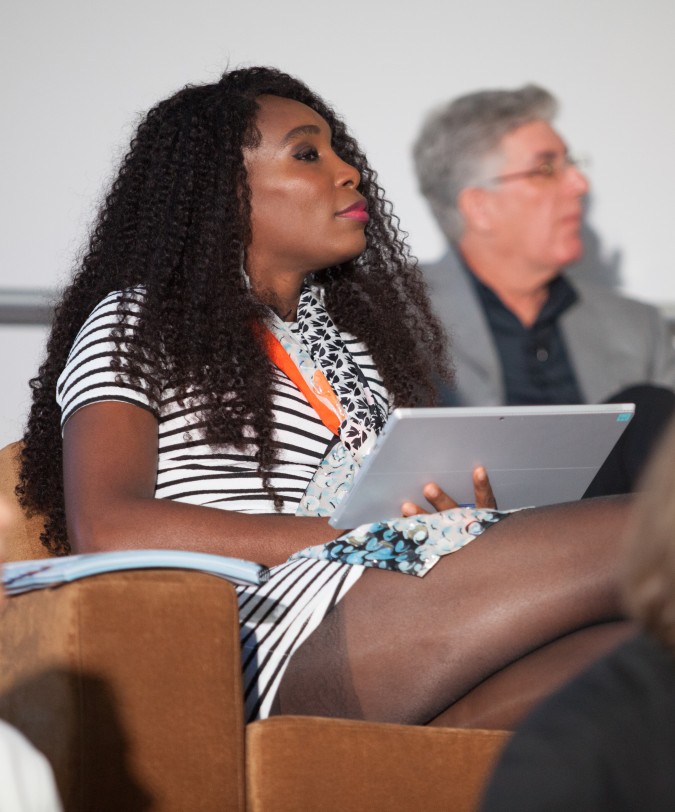Archive for the ‘Venus Williams’ tag
First annual Intel Make it Wearable competition November 2, 2014
On Sunday afternoon, November 2, 2014, I had the pleasure of attending the first annual Intel Make it Wearable to identify exciting technology companies making or proposing to make computers that one wears rather than carries or is stationary.
Make it Wearable is an ambitious new competition, and it’s the most polished and exciting competition I have attended. That’s saying something as I have attended dozens of competitions over the years.
The ten finalists come from China, Chile, the United Kingdom, Germany and the United States. The ideas were wonderfully diverse as you’ll soon learn which helped to keep the event lively and full of surprises. Sex appeal for business competitions is desirable because it helps attract the press and future competitors. I saw reporters from Yahoo and CNet at the event, and even reporters from the Middle East.

Venus Williams listening to a pitch as a judge for the 2014 Intel Make it Wearable competition on November 2, 2014. Note the Intel chip containing Microsoft Surface Pro tablet computer Williams is holding. The judges voted via these tablets.
Before I jump into the companies, allow me to talk about the event venue, the W Hotel across the street from the Moscone Convention Center in San Francisco, California USA. This was a great choice. The W is very fashionable. It’s not dull and boring like so many big hotels. Intel didn’t just go with a standard W event room though. A designer outfitted the rooms with custom wall textiles that resembled old barn wood and white painted bricks. This theme carried through to the custom printed name tags. There were light sculptures that featured dozens of clear globed incandescent light bulbs dimmed enough you could see the glowing filaments without squinting. These bulbs were dangling down on wires, and the idea was to reference the light bulb over the head to bring up the idea of a fresh new idea being thought up.
There was a disc jockey ever present in the two rooms, though one used her RFID embedded fake fingernails to manipulate a musical track by dipping her fingers in a shallow clear box of water. She got a lot of attention for this, and it was mesmerizing to watch. I learned this was her first gig playing music by playing with water.
The rooms were packed, and the crowd was surprisingly stylish and hip… far, far more hip than the crowds at the business competitions I have attended on college campuses. The only negative is that the event was not open to the public, a big change from previous Intel business competitions I have attended for years in Berkeley, California. I suspect the reason is that this first year was an experiment for Intel, and they wanted to test things out before widening the audience base. I was invited by Intel, a company that has been very kind to me over the years. My last Internet startup was an Intel Capital portfolio company.
My favorite company is Pro Glove, out of Germany. This team won third place and USD $100,000 in the competition.
Pro Glove makes solutions to improve the accuracy and speed of production factory workers. The company says there are 200 million such workers in the world.
The company sells gloves, sensors and software to process the data returned by the globe embedded sensors. Factories apparently for the first time can see exactly what workers are doing with their hands. If a worker skips a production step, the software can spot the mistake and flash a light on the glove to warn the worker to go back and complete the step. The glove analytics software can even tell where the worker is standing in the factory, so if they are walking around needlessly to fetch tools, the manager can spot that an perhaps move the tools closer to the worker to save walking time.
Pro Glove said that for BMW, each second saved on a repetitive task making a car translates into USD $7,500 per year savings for BMW, so having analytics about hand movements of production workers strikes me as a must have. Pro Glove cited various return on investment periods for their different use scenarios. Sometimes the system is predicted to pay for itself in a year, and sometimes in just there months.
I can see Pro Glove gloves being a must have in leading edge factories, and I can see room for lots of follow on products that will have high margin, particularly for the software designed to analyze the glove data. I think a large and enduring business can be built, and that is why I give this team my highest vote.
My second favorite team is Open Bionics, out of the United Kingdom. This team won second place in the competition.
Open Bionics proposes to make low cost three dimensionally printed bionic hands for children. The team proposes a price of just USD $2,000, which apparently is shockingly low compared to current bionic hands, which they said can cost up to $100,000 each.
The Open Bionic model is not as durable or as functional as the models costing 50 times more, but the low cost allows families to fit their handless children with a bionic hand multiple times as needed as they grow up. Apparently insurance won’t pay for a new $100,000 bionic hand each year for a growing child, so handless kids just grow up without handless until they stop growing and can get a fully featured metal bionic hand. Open Bionics was not specific about how current costly models are paid for and how often they are replaced, thus I am reading between the lines a bit here in this paragraph.
The Open Bionic team proposes to keep the cost low by not having patients meet with any medical professionals. Instead, the company will send an Apple iPad brand computer tablet with a 3D scanning attachment to the patient by postal mail. The customer will scan their own arm stump and return the iPad to the company. The company then prints out and assembles a hand that will fit the exact stump dimensions of the patient, and the hand will just show up at the customer’s home by common carrier, to be self installed by the customer.
The hands don’t have a wrist joint, but they can open and close by the wearer just thinking the same thoughts handed people think when they want to open or close their fist. There are electrode sensors that are taped to the forearm of the wearer, and the Open Bionic team had the electrodes on his own arm, and could make the bionic hand open and close just by his thoughts controlling his forearm muscles. It was an impressive demo.
I got to play with one of the bionic hands, and I could feel the hand squeezing my hand when activated by a push button ‘demo’ switch.
Open Bionics has the opportunity to dramatically improve the life of handless children. The price proposed frankly seems too low to keep the company afloat, so I worry about their viability. But the price can be adjusted, and since the team won USD $200,000 in this competition, they have some breathing room to figure out both their technology and the business.
My third favorite team is Nixie. This team won the grand prize in the competition — USD $500,000.
Nixie had the most eye popping video demonstration of their product.
Nixie proposes making a tiny drone helicopter that contains a still and video camera. The drone can fold up and wrap around a person’s wrist. With the flick of the wrist, the drone can be unfolded and then can start up and take flight away from the wearer. Once at a suitable elevation and distance, the camera can face the use and take a picture or start recording. Once done, the drone will fly back to the user and turn off.
Nixie sees itself as a competitor to Go Pro and similar action cameras. Eventually Nixie says they want to compete with normal point and shoot digital cameras.
I held a prototype Nixie drone in my hand, and it is cute. However, it looks impossibly fragile and totally unsuited to wearing while rock climbing, the stated first market Nixie envisions. I can see the drone simply falling off the wrist and falling on someones head below.
But I am happy Nixie won first place in this competition. The idea I think will wow many observers, and it will help brand the competition as one where really cool consumer products can be born and launched. That’s good for Intel and good for the competition.
But I think Nixie won by making the drone wearable as a way to be eligible to compete in this competition. In the absence of the competition, I think the product would have taken a different form. If I were rock climbing, I would want the drone in a protected case that I could easily open and access when the time was right for taking pictures.
Nixie is likely to be costly to start. I can see it costing USD $1,000 to early rock climbing adopters. I think they will find customers even at this price.
I don’t think there are strings attached to the Intel half million dollar prize, so I think that Nixie is welcome to ditch the wearable aspect in favor of practicality. I encourage them to go that route, even though it may secretly irritate Intel.
I admire Nixie for getting a non dilutive $500K to pursue their photography drone. This kind of thinking is the hallmark of successful entrepreneurs — tailoring an offering for the market at hand. Intel was the customer, and Nixie gave Intel a product it asked for. And Intel will be proud of Nixie even if they just become a successful photography drone company.
I can also imagine ways to make a Nixie both wearable and very unlikely to get damaged during arduous climbing. Just put it into a head mounted hard case inside a custom helmet. When the time comes, the helmet wearer could command the helmet to open and for the drone to take off from there. This could even be voice activated via a helmet mounted microphone.
Sadly, I don’t have time right now to finish this post. My grandmother is turning 103 years old December 12, 2014, and I have a project I have to finish by then as I promised her I would take it to show her. I have already spent three days on this Make it Wearable competition, and I need to get back to my regular life. I have a lot more pictures to post, and I want to tell you about the seven other companies, which also are very interesting.


